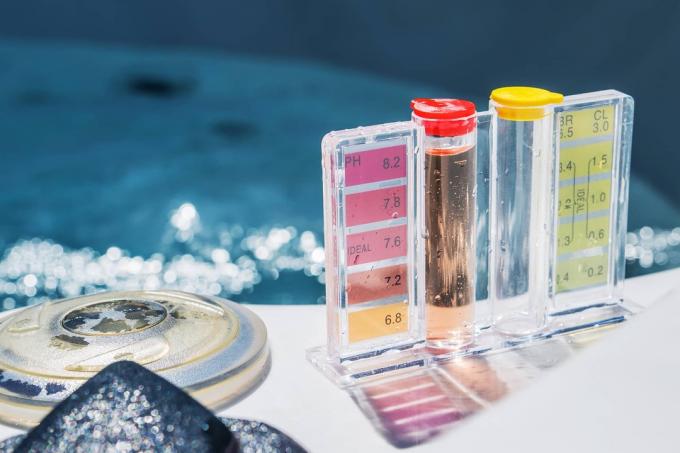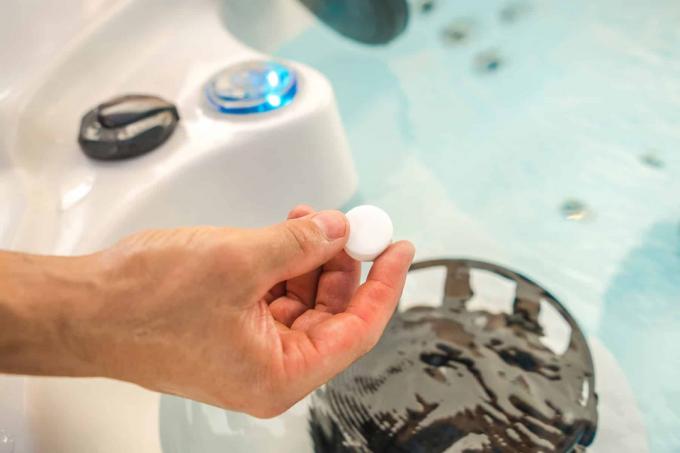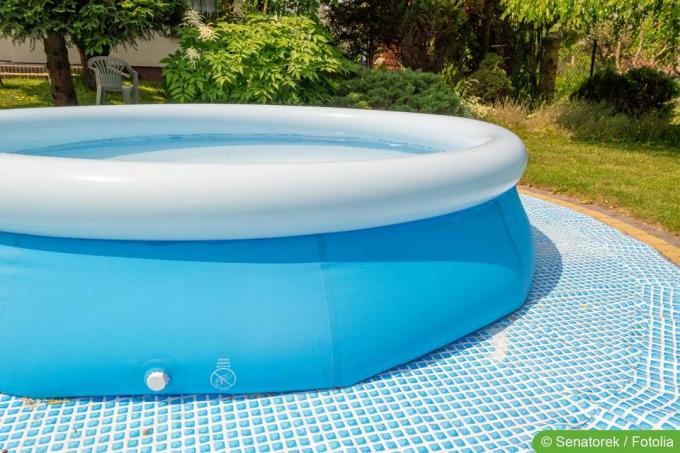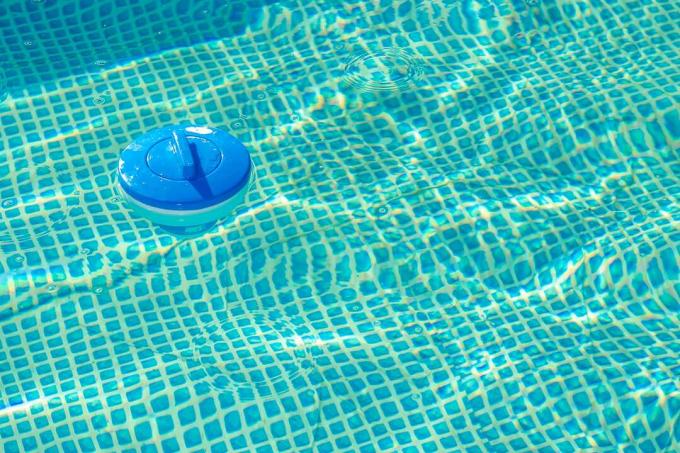

Table of contents
- function
- Test pool water
- chlorine concentration
- Dangers of overchlorination
- Dosage – Factors
- frequently asked Questions
Chlorine can keep pool water clear or, as shock chlorination, remove cloudiness and green discoloration. The question of how the right dosage and the optimal values look like arises again and again. This guide provides comprehensive answers.
function
Chlorine acts as a disinfectant in the pool, killing germs and pathogens. This reduces the risk of diseases and inflammation. A filter alone is not sufficient for this, as it cannot reliably remove all particles.
Chlorine is therefore part of regular and ongoing pool maintenance. However, it can only develop its effect if the ideal chlorine value is reached.
Test pool water
A quick and easy way to determine the chlorine value is to use test strips. These are only briefly held directly in the water to determine the value.

On the one hand, this is important in order to be able to adjust the amount of the agent accordingly and, on the other hand, to avoid the dangers of too high a content.
Tip:
Depending on various factors, the chlorine value varies greatly and over a very short period of time. The test should be done regularly and at short intervals to find the right dosage and to maintain safety.
chlorine concentration
There is no general answer to the question of how much chlorine should be added to 1,000 liters of water. But there is an ideal chlorine concentration. This is the “free chlorine” content. This has not yet been used up and can therefore still have a disinfecting effect.
- Minimum content: 0.3 to 0.5 mg per liter
- Optimal value: 0.5 to 1.0 mg per liter
- Maximum value: from 1.5 mg per liter
With a chlorine concentration of less than 0.5 milligrams per liter, the water threatens to become cloudy, turn green or even tip over completely. The effort for cleaning is then increased. There is also a risk of infection. Often only the combination creates here shock chlorination and comprehensive cleaning remedy.

Concentrations of up to one milligram are ideal for bathing. If the value is significantly higher, there are various dangers.
Dangers of overchlorination
The pool should not be used immediately after shock chlorination or if the concentration is accidentally too high, as there are health risks. These are:
- difficulty breathing
- rash
- nausea
- burning, irritated eyes
- skin irritation
- Coughing up to bloody sputum
- dizziness
- acid burns
Children and sensitive people in particular or people with existing respiratory diseases can quickly find themselves in dangerous situations as a result of chlorine poisoning. It is therefore all the more important to dose carefully on the one hand and to test on the other. In addition, there are often clear warning signs even without test strips. These include a strong smell of chlorine and burning eyes.

Tip:
Especially in summer, the chlorine concentration drops again quickly. In the event of overchlorination, it is often sufficient to refrain from using the pool for a few days.
Dosage – Factors
Various factors play a role in the correct dosage of chlorine for 1,000 liters of water. These include, among others:
- occurrence of contamination
- dosage form
- intensity of use
- concentration
- temperature
- UV radiation
In midsummer, with daily bathing or when additional dirt such as dust is brought into the pool by wind and thunderstorms, the chlorine is used up very quickly. The high temperature favors the multiplication and spread of germs, which requires more disinfection.

The information provided by the manufacturer is fundamental when it comes to dosing chlorine. These can vary greatly depending on the dosage form (granules, tablets or liquid) and the concentration of the product in question.
Tip:
If, despite the correct dosage, it turns out again and again that the chlorine value in the pool is significantly too high or too low, the manufacturer's information can be adjusted accordingly. Regular tests should also only be carried out when the chlorine has been able to be evenly distributed in the pool.
frequently asked Questions
The chlorine content should be checked regularly with test strips once or twice a week. In addition, a check after shock chlorination or in the case of recurring severe cloudiness and other abnormalities is recommended.
The optimal values are between 0.5 and 1.0 milligrams per liter of water. In very hot weather, strong sunlight and intensive use of the pool, the value can be increased to 1.2 milligrams of chlorine per liter. In this case, the disinfectant is quickly used up. If the concentration is too low, germs can spread and deposits can form. For this reason, it still makes sense to chlorinate the water more frequently.
The amount of chlorine can be reduced by choosing a filter with the appropriate performance and UV light. Regular cleaning of the filter and the pool as well as protection against dirt are also important. If possible and safe to carry out, a cover is recommended when not in use.
Germs can spread almost unhindered. This leads, among other things, to slimy, streaky deposits on the floor and on the pool walls. The water becomes cloudy or green and may have an unpleasant odor. It also poses a risk of infection and inflammation.
 Home editorial office
Home editorial office
Learn more about water in the garden

How quickly does chlorine break down?
How quickly chlorine breaks down in pool water is important information for a number of reasons. It is important to know which factors play a decisive role in the degradation rate. This guide shows which influences are decisive.

Too much chlorine in the pool: what to do?
If too much chlorine accidentally ends up in the pool or the chlorine value is inexplicably high, there are several measures you can take. This guide shows what can quickly and sustainably help and reduce the chlorine content.

Too much chlorine in the pool: swim anyway?
If too much chlorine has ended up in the pool, the question immediately arises as to whether bathing is still possible. What risks can this entail and what are the warning signs? Here are the answers.

Reducing chlorine levels in the pool: chlorine levels explained
Is the chlorine level in the pool too high and bathing is not possible? Then good advice does not have to be expensive, because the chlorine values can be easily reduced in several ways and thus brought into the optimal range.

Pool initial filling: initial chlorination dosage
When the pool is about to be filled for the first time, the question of initial chlorination also arises. When and how is it carried out and what dosage is correct. This guide shows step by step how to do it.

Shock chlorination / shock chlorination with green water
If the pool water is milky or even green, shock chlorination can help. This guide to shock chlorination shows how to proceed, what dangers exist and what else needs to be taken into account.


